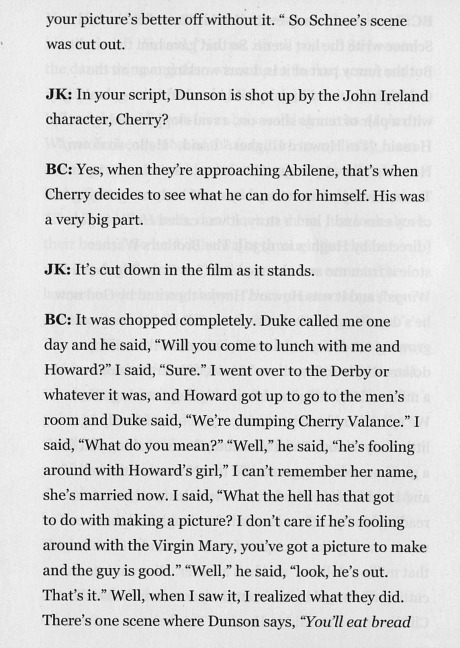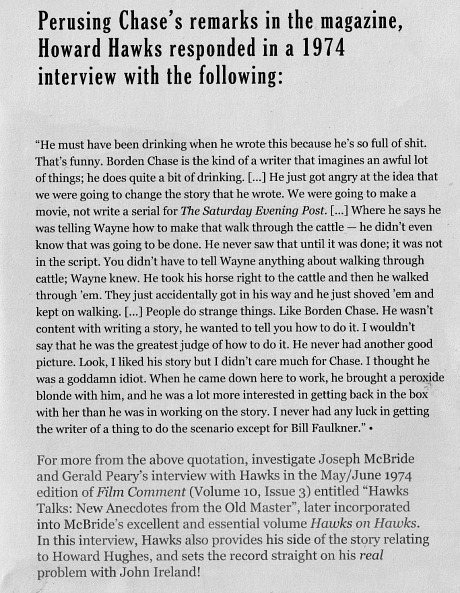In the booklet inside the new Masters of Cinema Red River Bluray there’s an excerpt from a 1970 Film Comment interview with Red River screenwriter Borden Chase. Changes that were made to Chase’s screenplay by director Howard Hawks are discussed with interviewer Jim Kitses. One of these was Hawks’ decision to cut down John Ireland‘s Cherry Valance role, allegedly due to resentment on Hawks’ part about Ireland having scored with a woman Hawks had been having relations with. Hawks dismissed Chase’s account (which came allegedly came straight from John Wayne) in a subsequent interview. He asked if Chase was sloshed when he said it, and said he “was so full of shit.” I don’t believe Chase was fantasizing, but that’s me.





Earlier this year I asked Hollywood Reporter critic and Hawks scholar (“Howard Hawks: The Grey Fox of Hollywood“] Todd McCarthy about the Hawks-Ireland animus and he answered with excerpts from his book:
“Aside from the ending, the most significant story change Hawks made on location was the radical hatchet job he did on Cherry Valance’s character. This was due almost entirely to Hawks’ displeasure with John Ireland. In stark contrast to Monty Clift, Ireland didn’t take his big break seriously, didn’t work hard, didn’t become a cowboy. Instead, he was usually drunk or stoned, and unreliable in his scenes. He also started an affair with Joanne Dru, whom he later married. (It has often been claimed that Hawks became incensed because the director himself was involved with Dru, but it was her husband, Dick Haymes, who would have had cause to be jealous.) Everything about Ireland’s approach to his work rubbed Hawks the wrong way, and he reacted by whittling his part down as much as he could, giving his lines to others, and depriving him of his pivotal role in the story’s climax.”
McCarthy also wrote that “once the production returned to Hollywood for interiors at the Samuel Goldwyn Studios, Ireland continued his provocative behavior, launching an affair with Shelley Winters — visible in just one shot in the finished picture as a dance-hall girl — that was at least partly carried on, according to more than one cast member, in a covered wagon on the soundstage. One day when Ireland was needed for a scene, Hawks sent Harry Carey Jr. and stuntman Cliff Lyons to find him, which they did, in the self-same wagon, snoozing away. Lyons awakened him by giving him a powerful kick in the side. Later, Hawks said that Ireland apologized for his lack of professionalism during the shoot and, promising to change his ways, begged for another chance on another picture. But Hawks had had more than enough.”
“The kicker, which relates humorously to the famous scene in which Clift and Ireland compare guns and size each other up with lines loaded with gay subtext — ‘That’s a good-looking gun you were about to use back there. Can I see it?’ and ‘Maybe you’d like to see mine?’ — is that Ireland was well known to pack one of the biggest rods in Hollywood, comparable to Milton Berle and Dan Dailey. One can only speculate as to whether or not this further compelled Hawks to want to cut him down to size.”
Incidentally: Chase’s Wiki page reports that “[he] was an active member of the Motion Picture Alliance for the Preservation of American Ideals, an anti-Communist group which was active in Hollywood during the years of the Hollywood blacklist. His daughter Barrie Chase is a dancer and actress, and his son Frank Chase was an actor and screenwriter.”
